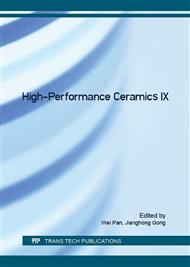[1]
R. A. Lefever, J. Matsko, Transparent yttrium oxide ceramics, Mater. Res. Bull. 2 (1967), 865-869.
DOI: 10.1016/0025-5408(67)90096-7
Google Scholar
[2]
Y. Nigara, Measurement of the optical constants of yttrium oxide, Jpn. J. Appl. Phys. 7(4) (1968), 404.
DOI: 10.1143/jjap.7.404
Google Scholar
[3]
A. L. Micheli, D. F. Dungan, J. V. Mantese, High-density yttria for practical ceramic applications, J. Am. Ceram. Soc. 75(3) (1992), 709-711.
DOI: 10.1111/j.1151-2916.1992.tb07863.x
Google Scholar
[4]
S. Balakrishnan, K. Ananthasivan, K. C. H. Kumar, Studies on the synthesis and sintering of nanocrystalline yttria, Ceram. Int. 40(5) (2014), 6777-6785.
DOI: 10.1016/j.ceramint.2013.12.001
Google Scholar
[5]
X. R. Hou, S. M. Zhou, Y. K. Li, et al., Luminescent properties of nano-sized Y2O3: Eu fabricated by co-precipitation method, J. Alloys Compd., 494(1) (2010), 382-385.
DOI: 10.1016/j.jallcom.2010.01.054
Google Scholar
[6]
J. Dhanaraj, R. Jagannathan, T. R. N. Kutty, et al., Photoluminescence characteristics of Y2O3: Eu3+ nanophosphors prepared using sol-gel thermolysis, J. Phys. Chem. B. 105(45) (2001), 11098-11105.
DOI: 10.1021/jp0119330
Google Scholar
[7]
L. Mančić, V. Lojpur, B. A. Marinković, et al., Hydrothermal synthesis of nanostructured Y2O3 and (Y0. 75Gd0. 25)2O3 based phosphors, Opt. Mater. 35(10) (2013), 1817-1823.
DOI: 10.1016/j.optmat.2013.03.006
Google Scholar
[8]
S. Ekambaram, K. C. Patil, Combustion synthesis of yttria, J. Mater. Chem. 5(6) (1995), 905-908.
Google Scholar
[9]
R. V. Mangalaraja, J. Mouzon, P. Hedström, et al. Microwave assisted combustion synthesis of nanocrystalline yttria and its powder characteristics, Powder Technol. 191(3) (2009), 309-314.
DOI: 10.1016/j.powtec.2008.10.019
Google Scholar
[10]
M. F. Carolan, J. N. Michaels, Chemical vapor deposition of yttria stabilized zirconia on porous supports, Solid State Ionics. 25(2) (1987), 207-216.
DOI: 10.1016/0167-2738(87)90122-6
Google Scholar
[11]
Y. C. Kang, H. S. Roh, S. B. Park, Preparation of Y2O3: Eu phosphor particles of filled morphology at high precursor concentrations by spray pyrolysis, Adv. Mater. 12(6) (2000), 451-453.
DOI: 10.1002/(sici)1521-4095(200003)12:6<451::aid-adma451>3.0.co;2-s
Google Scholar
[12]
M. Rekha, K. Laishram, R. K. Gupta, et al., Energy-efficient green synthesis of Nd: Y2O3 nanopowder by microwave gel combustion, J. Mater. Sci. 44(16) (2009), 4252-4257.
DOI: 10.1007/s10853-009-3615-4
Google Scholar
[13]
A. M. Khachatourian, F. Golestani-Fard, H. Sarpoolaky, et al., Microwave assisted synthesis of monodispersed Y2O3 and Y2O3: Eu3+ particles, Ceram. Int. 41(2) (2015), 2006-(2014).
DOI: 10.1016/j.ceramint.2014.09.105
Google Scholar
[14]
B. D. Culity, S. R. Stock, Elements of X-ray Diffraction, Reading: Addition-Wesley, (1978).
Google Scholar


